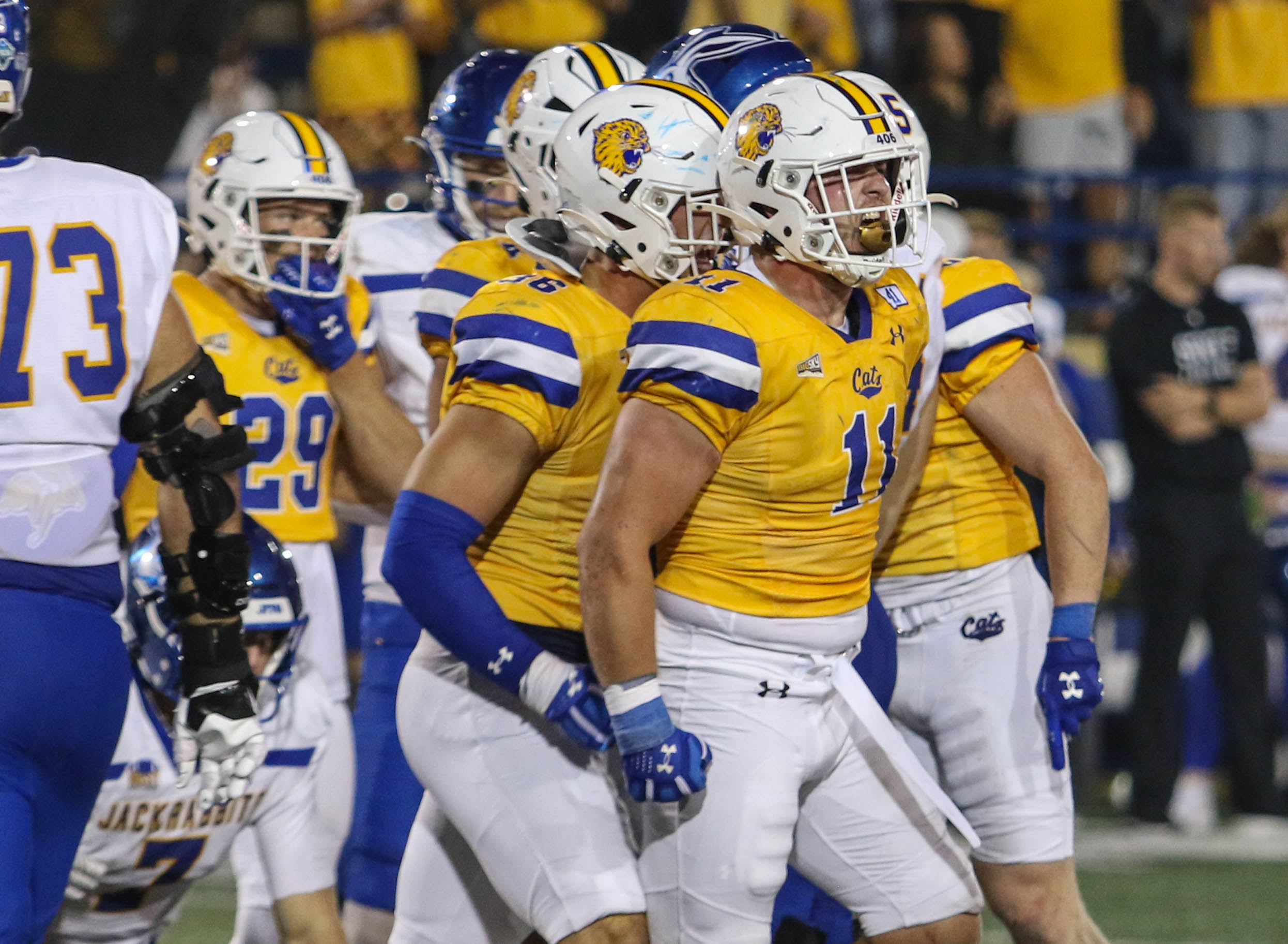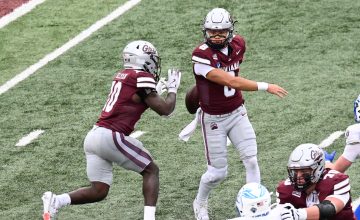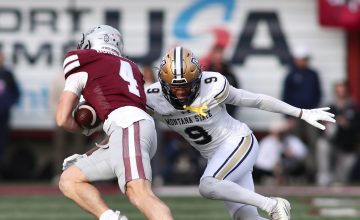Montana State’s football season has had some great play up on top, mostly a lot of good in the middle and some bad on the bottom so far this year. Up top, the Bobcats defensive line has been a torture chamber for opposing offenses that have been unable to get untracked for the most part over the first five games of the season. But down low, the kicking and punting has featured two key missed field goals, three harmless missed extra points, three blocked punts – one damningly so – and a poorly timed out of bounds kickoff.
The defensive line has been a major reason MSU has been doing things no defense in school history has done in nearly 100 years. The steady rotation of eight defensive linemen has shown little drop off when presented in any combination wearing down opposing offensive lines and by virtue opposing quarterbacks.
Montana State has only allowed 20 points over the past four games and just 37 in the past five games during regulation. The 20 points in four games is the lowest output allowed since the 1929 Bobcats held teams to 12 under then head coach Schubert Dyche. The Bobcats haven’t allowed 300 yards in a game in the past five games.
You’d think there would be a substantial decrease in productivity when a team is starting four seniors – defensive ends Hunter Parsons and Kenneth Eiden IV along with tackles Alec Eckert and Paul Brott – with two being All-Big Sky selections and their backups are two sophomores – tackle Talon Marsh and end Dominic Solano – and two juniors – end Zac Crews and tackle Zack Black. The decrease, if there is one, is negligible.
Eliminating the statistics from the season-opener against FBS No. 2 Oregon, the Bobcats are allowing just 3.9 yards per play and 2.6 yards per rush. To put those numbers in perspective, the 3.9 per play is 1.3 better than the second-best team in the Big Sky and if you go another 1.3 down the list it takes you all the way down to the tenth-place team. The 2.6 per carry is also 1.3 yards better than the second-best team and if you go another 1.3 down it takes you down to the 11th place team.
MSU’s top asset is likely its stamina, which isn’t just conditioning but also by design. Having eight players rotate throughout the game means that they’re not going to get worn down like so many defensive fronts do, especially if the opposition is keeping them on the field. Tired defensive lines equate to allowing opposing offenses the ability to run and control the ball and clock when the fourth quarter rolls around. That hasn’t happened to MSU. In fact, of the four touchdowns the Bobcats have allowed during regulation in the last five games, only one has occurred in the second half, and that was in a game they led 38-0 in the fourth quarter against San Diego.
That stamina was put to the test last Saturday in Flagstaff for reasons aside from the 7,000-foot elevation.
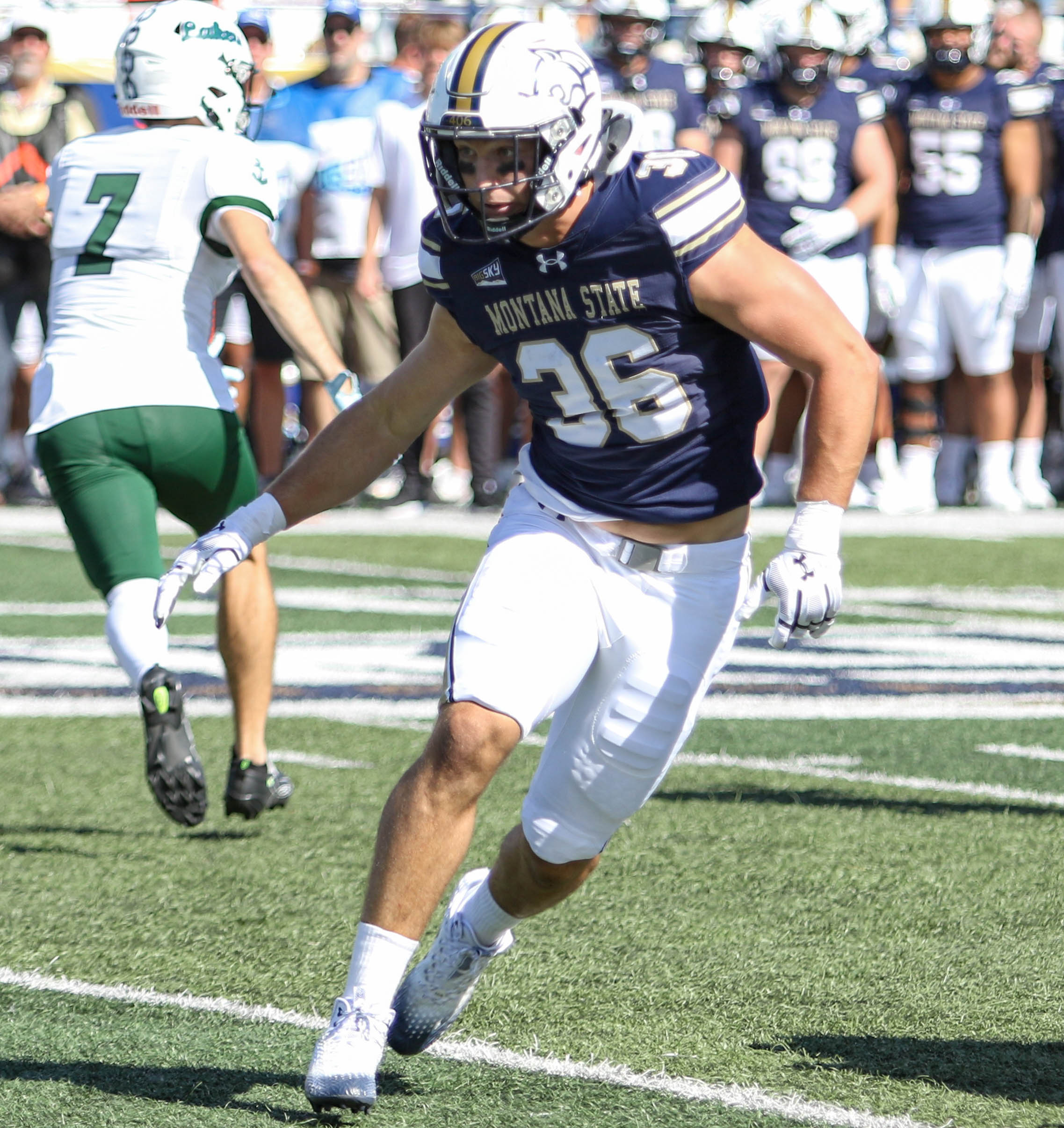
“We played 80 plays,” Vigen said. “We had a couple quick scores from both the special teams and offensively, so (NAU’s) plays really piled up. I know looking at the stat sheet they had already thrown 31 times. That’s a lot of times rushing the passer. It’s a job that isn’t just built for four guys. We played that game with eight guys. It challenges us to figure out how can we get that to 10 and really allow for that relentless nature to be evident each and every play and that’s keeping guys fresh.
“That’s not only within a game but over the long haul of a season. We’re six games into the season and that’s just starting to take its toll on guys, so the more we can continue to have the second teamers and adding to that group the better off we’re going to be and we’re healthy there right now but that doesn’t guarantee us that we’re going to be healthy all the way through. That is a driving force for our defense.”
Finding the right mix to get his defensive line to this point hasn’t been easy for Vigen, but he knows it’s a necessity.
“Those starting four seniors are playing at a really high level,” Vigen said. “Those (second string) guys being conditioned to do more than they ever have before. That’s definitely the confidence that needs to be gained with the next group of guys. Those reps needing be up each and every week. Where we were last week even going back to the second game of the year, we were really heavy to that top group against South Dakota State and I said a lot in that game, that has got to change.
“We were in that game and every play seemed like it was the biggest play of the game. We gotta get to a point sooner than later where if we have a second group of guys or a second combination out there, that’s okay. That second group is going to be every bit as effective and ultimately when we hit the fourth quarter and we need the top group to be running hot, they’re running hot. It’s a process, it’s a credit to the coaching staff, it’s a credit to that top group, it’s a credit to those younger guys being hungry and wanting to get out there. (Players telling themselves) coming in here on Monday and all week, if I’m gonna get on the field I’m gonna do this, this, this and this right. Those guys in that second group are doing a better job of that.”
The synergy between the defensive line and the secondary is paramount to the ability of getting after the quarterback. The Bobcats, unofficially, had 23 occurrences where they were able to make NAU quarterback Ty Pennington move out of his comfort zone.
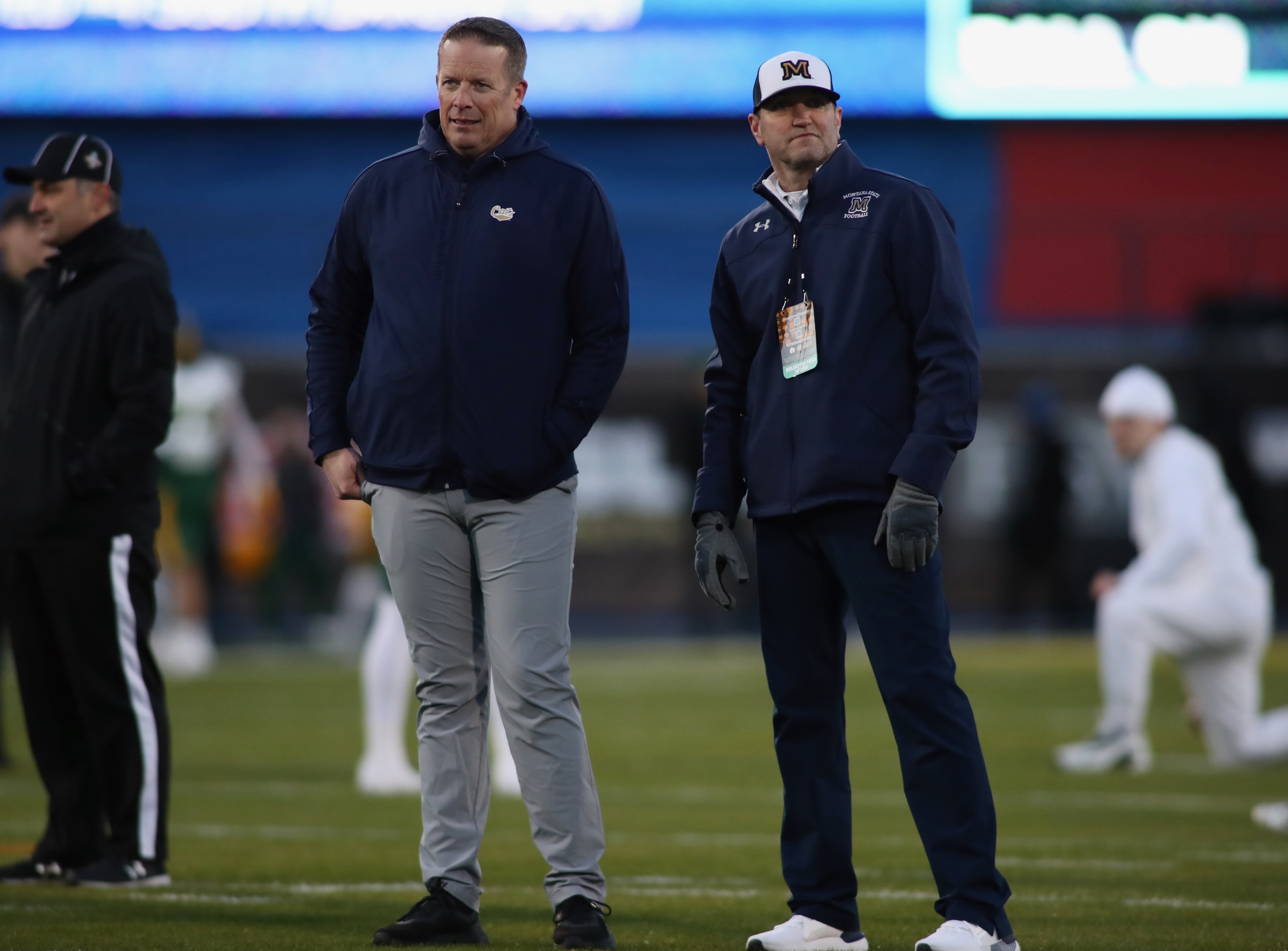
“You gotta be able to mix it up coverage-wise so everything isn’t easy access,” Vigen said of his secondary’s strategy. “Being able to limit the run game that they have, they’re going to pick and choose their times to run it. Really, you hope the down and distance can dictate them having to get the ball down the field. Having (the quarterback) hang on to it a little bit longer and that’s where your pressure exists. Some of its out of the defensive line’s hands on first and second downs. Do your job in the run game and hopefully the mix of calls can get them in longer yardage situations and be in those scenarios where you can pin your ears back and put the heat on.
“There’s a lot that goes into it. You look at plays Saturday and you see we’re covering well. When you’re covering well that’s contributing to the pressure, too. That’s where I think we’re a better team defensively at this stage than we’ve been in midseason in any of my years. Our continued ability to mix up coverage is something that we gotta be able to do especially against a team like (ISU) that’s going to throw it a whole bunch; the more looks you can give them, be sound in that regard, the better off you’re going to be.
The Bobcats face a live-arm quarterback in Jordan Cooke this week when Idaho State travels to Bozeman. Cooke is special in that can make passes from multiple platforms due to his significant arm strength. He also gets rid of the ball quickly, which decreases the effectiveness of the pass rush.
“Those guys coming off the ball and really being disruptive in the run game and doing their job in the run game,” Vigen said is a key to getting pressure. “Then we get teams in those obvious passing situations really being able to make those quarterbacks uncomfortable. We didn’t have crazy sack numbers but our pressures, our hits; those numbers were significant in that game on Saturday. We made a really consistent quarterback really uncomfortable. That’s what we needed to do and that’s what we need to do again this Saturday.”
The Bobcat’ defense has also shined in terms of penalties as they’ve only committed two in the last four games. Those two, coincidentally, were on the only drives that resulted in touchdowns over those four games.
The punting and kicking stories haven’t been as awe inspiring.
True freshman punter and kickoff specialist Colby Frojker is a man of many talents but even he has his down moments. A prep star at multiple positions on the gridiron, on the basketball court, javelin, and golf links got off to a rough start but seemed to have it all worked out until he mishit a kickoff near the end of the first half against NAU. Frojker had two punts blocked against Oregon in the season opener, then another against South Dakota State but after that he settled down until the NAU kickoff.
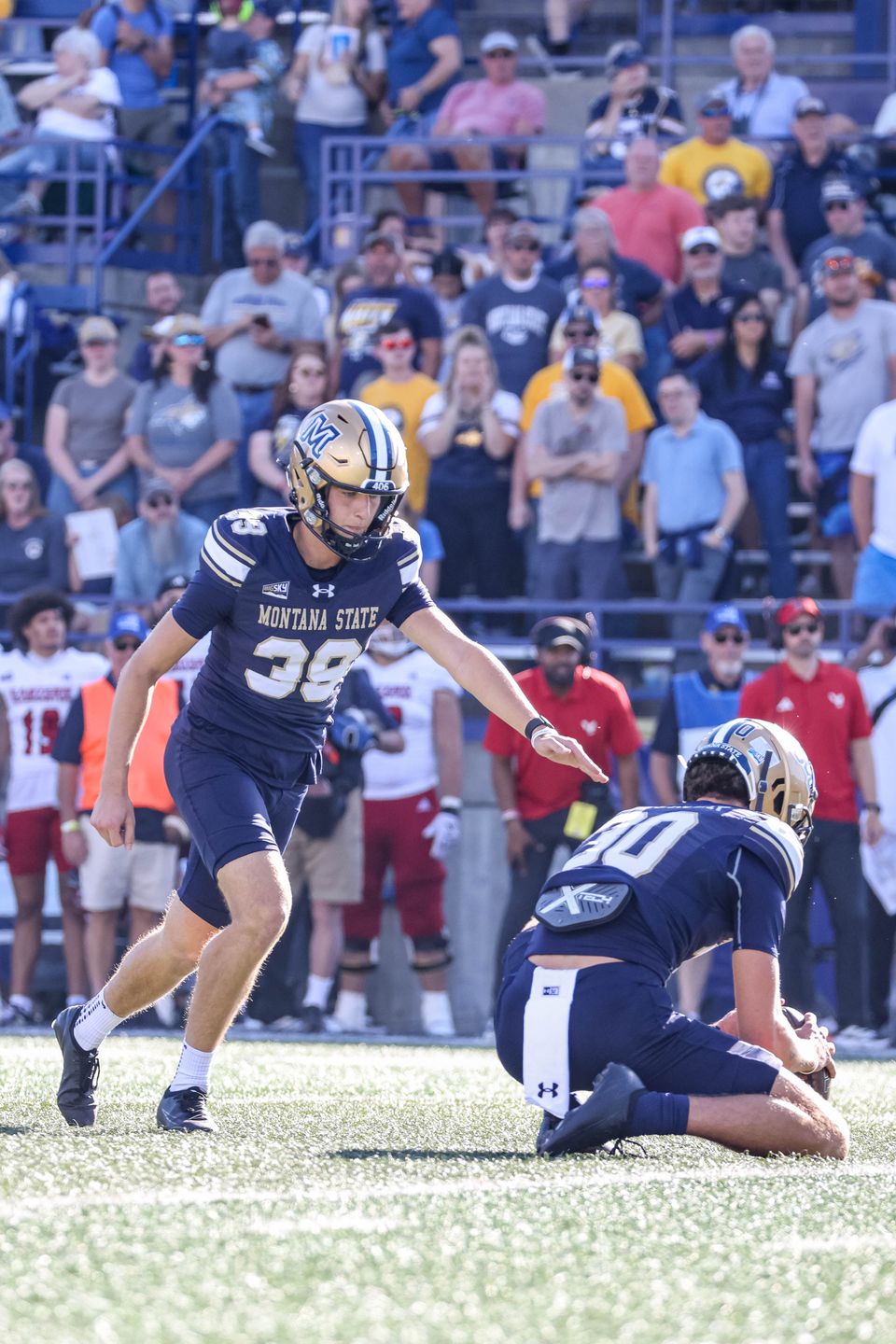
The timing of that miscue was exasperated by the fact that MSU had committed an unsportsmanlike conduct penalty after a touchdown run by Julius Davis. That meant Frojker would have to kick off from the MSU 20. A kick out of bounds would be another 15-yard penalty, so it was imperative that he hit it straight to allow his teammates a chance to mitigate the damage of the unsportsmanlike foul. His kick to a sharp left and went out of bounds to give NAU the ball on the 50.
“Just looking at Colby and long snapper Brody (Johnson),” Vigen said. “Colby has really flashed where he can be this big-time punter and kickoff specialist. Then he’s shown times where he’s mishit some balls, he kicks the ball out of bounds, those kinds of things. His ability to be consistent is what we’re chasing after. Brody’s the long snapper and has done a good job by and large. There’s improvement that can be had there, too.”
The Bobcat’ defense was able to hold the Lumberjacks to a field goal attempt, which they missed, and no damage was done.
Placekicker Myles Sansted, who sailed through the 2025 season nearly unscathed, has had his issues as well. Sansted started out the season well as he connected on a pair of field goals against Oregon but then missed what turned out to be a crucial field goal from 45 yards out against SDSU. He regrouped from there, however, and didn’t miss an extra point until just before halftime against Eastern Washington when he glitched on that attempt, then he came back and missed his first extra-point attempt of the second half. Neither miss was crucial because the Bobcats rolled to a 57-3 win over the Eagles.
Sansted was perfect on his first two attempts against NAU but would miss in between the unsportsmanlike conduct penalty and mishit kickoff, making it three straight erroneous plays by the Bobcats. Again, the errors didn’t ultimately cause any problems for MSU as they cruised to a comfortable 34-10 win over the Lumberjacks.
Special teams are just limited to the specialists, however, and the return and cover players have been solid, yet not perfect.
“All the different second-year guys that we have do recognize that ‘this is my opportunity to get on the field and make an impact,’” Vigen said. “That’s a pretty good list of guys and their effort has been awesome. I know for (first-year special teams) coach (Marcus) Monaco it’s what all can we ask them to do? What’s going to be both the execution and the effort? Not just the effort. That’s where, as we go into each week, fine tuning the plan so we can get both of things – the execution and the effort. The execution and the effort showed up on the (Taco Dowler) punt return. Those are all young guys that are springing that deal for Taco. Taco, yes he ran the 90 yards, but it was set up pretty well for him, guys really hustling.
“We’ve had a bunch of plays like that, but we’ve had some plays that unfortunately you shake your head at. We gotta eliminate those because winning the special teams battle especially as the season goes along, those margins are pretty thin sometimes. We’re not always going to get a 90-yard punt return to tilt the scales in our favor. From a plan perspective it’s those guys owning the plan, it’s the staff coming up with a plan we can really match the execution to the effort that we’re seeing. In the ability there’s a good reason those guys are out there. Their ability is definitely there and they’re hungry for the opportunity.”
The Bobcats face Idaho State at Bobcat Stadium Saturday at 1:00.


